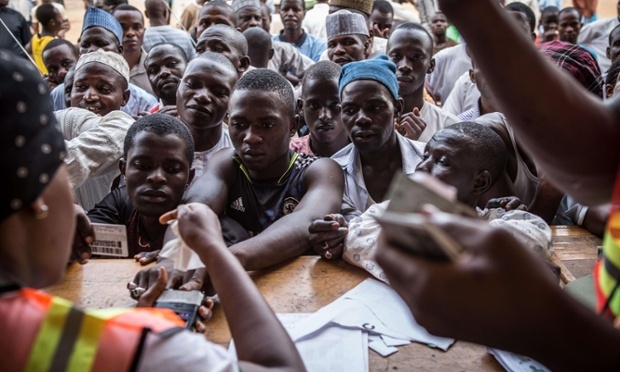Opinion
Chidi Anselm Odinkalu: How many voters are there in Nigeria?

Numeracy is a Nigerian problem but electoral democracy is about counting numbers. Nigerians will vote to elect a president and national legislators on 25 February. On 11 March, they will return to elect state legislators in 36 states and governors in 28. The numbers that will frame all these contests are now settled. They deserve close attention.
In all, 18 political parties will field a total of 15,307 candidates, including 1,553 women for 1,491 offices, including the presidency; 28 governorship offices; 109 senators; 360 in the House of Representatives members; and 993 seats in state houses of assembly.
Voting will take place in 176,846 polling units nationwide, located in 8,809 wards or Registration Areas in 774 local government areas. The Independent National Electoral Commission (INEC) says it has acquired at least 194,464 Bimodal Voter Accreditation System (BVAS) machines for the election to be managed by over 1.4 million ad-hoc officials.
By far the most important figure, however, is the number of registered voters. When Nigeria last voted in a general election in 2019, there were 84,004,084 voters on the electoral register. Through its Continuous Voter Registration (CVR), INEC says it captured another 12,298,944 since then. When it ran these entries through its Automatic Biometric Identification System, (ABIS), INEC discovered that 2,780,756 (22.6%) were ineligible or invalid. So, the register of voters in Nigeria has grown by 9,518,188 or 11.33% to 93,522,272 since 2019.
The names on the register notionally represent the people to ultimately decide who becomes Nigeria’s next president. This is why the register deserves attention. There is another reason the number of voters matters. Complaints about “voter apathy” in Nigeria persist. The numbers and patterns seem to bear this out. In 1999, turnout was 52.3%. Officially, it grew to 69% in 2003; and it has fallen, since then, to 57.5% in 2007; 53.7% in 2011; 43.7% in 2015; and a historic low of 34.8% in 2019.
Nigeria has always had a problem with numbers, especially of people and of votes. To be fair, voting numbers can be problematic everywhere because they are ambulatory. People are not static: they die by the second, relocate, or migrate. The register of voters does not automatically change because a person whose name is on it has died or moved. So, every voters’ register, at best, represents a snapshot in time.
However, there are many curious things about voting numbers in Nigeria. One, they are an island entirely unto themselves, with no rational relationship to wider trends in the population. Nigeria’s pattern of supposedly precipitous collapse in voter turnout, for instance, is inversely proportional to the growth in Nigeria’s baseline population.
In 1999, Nigeria’s population was estimated to be 115,766,000. By the time the country voted in 2019, it had risen to 199,039,000, a growth of 83,273,000 or 71%. When INEC announced the number of voters on the register for the 2023 election on 11 January 2022, the population of Nigeria was estimated to be over 219,864,000. In other words, since 1999, Nigeria’s population has grown by over 104,098,000 or 89.92%.
By contrast, in 1999, Nigeria had 57 million registered voters. This rose by 5.26% or three million to 60 million in 2003 and then by 1.67% or one million to 61 million in 2007. By 2011, the number of registered voters had climbed by over 12 million to 73.53 million or 20.5%, representing an average yearly growth rate of nearly 5.12%, where previously it had grown by 1.31% in 1999 to 2003 and 0.42% between 2003 and 2007. By 2015, the population of registered voters had fallen to 68.83 million, a deficit of 4.7 million voters or 6.83%, representing an annualised rate of reversal of 1.71%. Yet, over the same period, Nigeria, a country with a median age of just under 18 years, had grown in population from an estimated 162.9 million to 181.2 million, an increase of 15.174 million or 11.23%, representing an annual growth rate of 2.8%.
These numbers and the patterns they reveal do not lend themselves to easy explanation. However, as the Justice Uwais presidential committee on electoral reform pointed out in its 2008 report, much of what passed for electoral numbers in Nigeria before 2011 was voodoo. Just to illustrate this point, the INEC does not have a breakdown of official results for the 2007 presidential elections but there are turnout figures for that election.
In 20 years from 1999 to 2019, Nigeria’s population rose by 71% but the population of voters rose by only 50%. With the latest numbers announced by INEC, Nigeria’s register of voters has grown by 36,522,272 since 1999 or 64.07%, a deficit of 25.83% when compared with the increase in Nigeria’s population over the same period. It is possible to speculate about what may explain this significant deficit in growth patterns between the general population and register of voters. Rational factors such as internal migration; agency dysfunctions in INEC, civic inertia or failure to register, or high transaction costs may explain some of this. But there remain worrying patterns that are not easily accounted for by these factors.
____________________________________________________________
Chidi Anselm Odinkalu
Disclaimer
It is the policy of NewsWireNGR not to endorse or oppose any opinion expressed by a User or Content provided by a User, Contributor, or another independent party. Opinion pieces and contributions are the opinions of the writers only and do not represent the opinions of NewsWireNGR
Always visit NewsWireNGR for latest naija news and updated naija breaking news.
NewsWireNGR Latest News in Nigeria
Send Us A Press Statement/News Tips on 9ja Happenings: [email protected]
Advertise With Us: [email protected]






